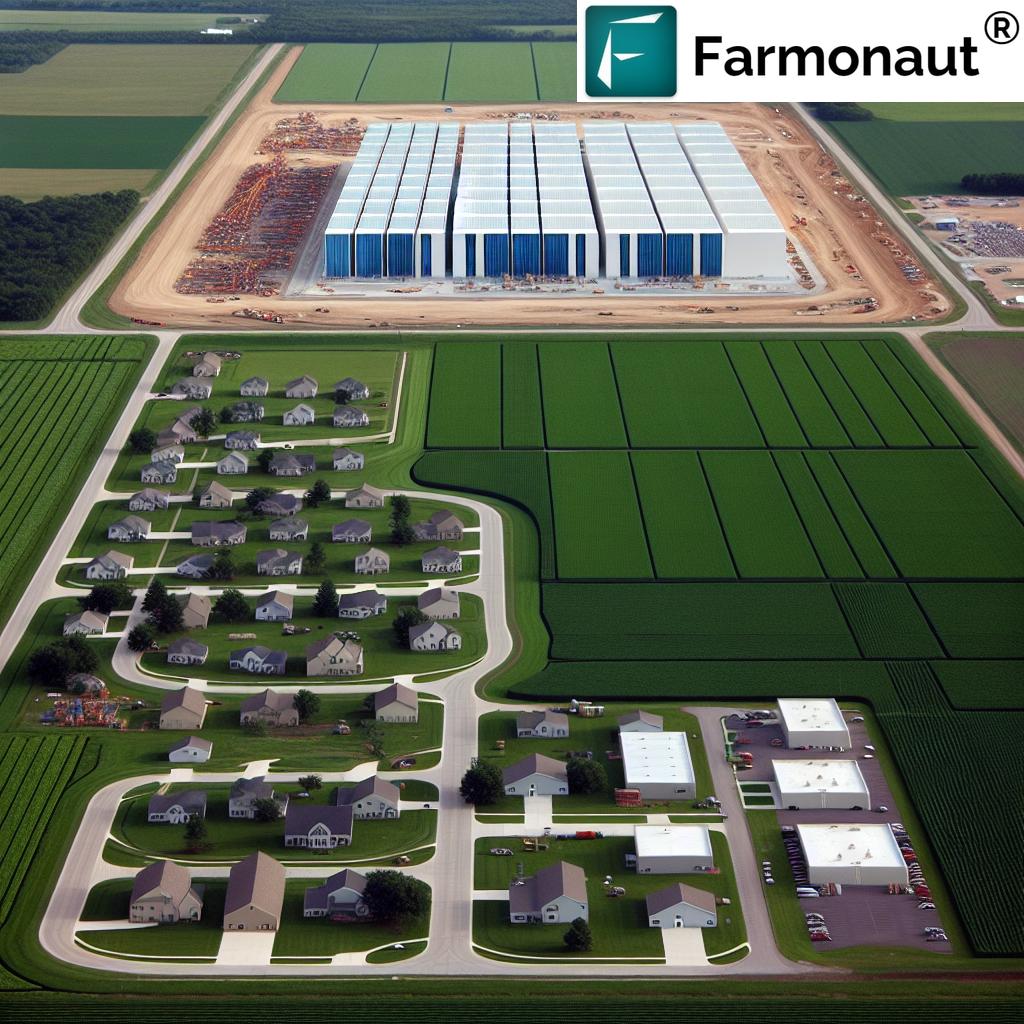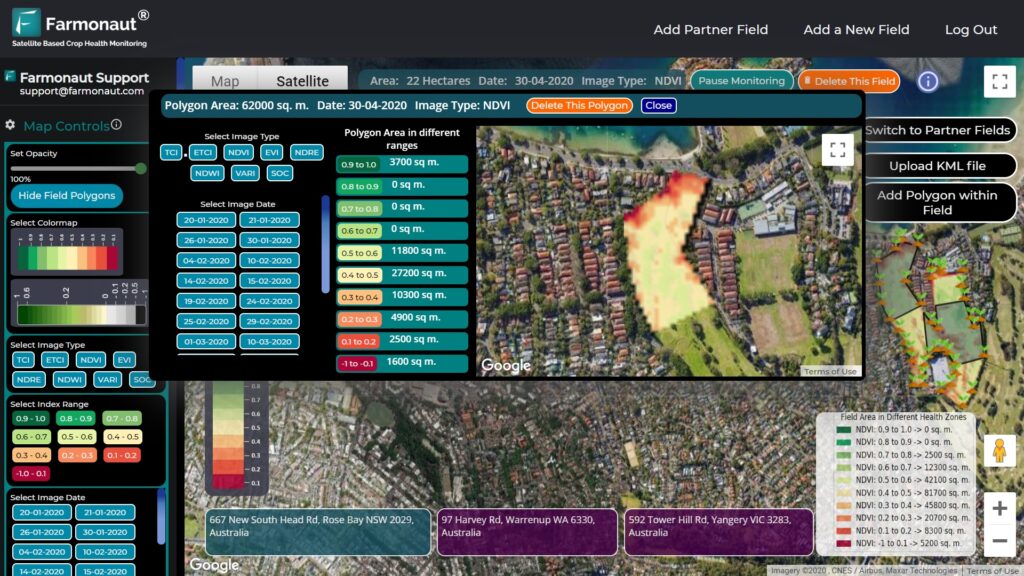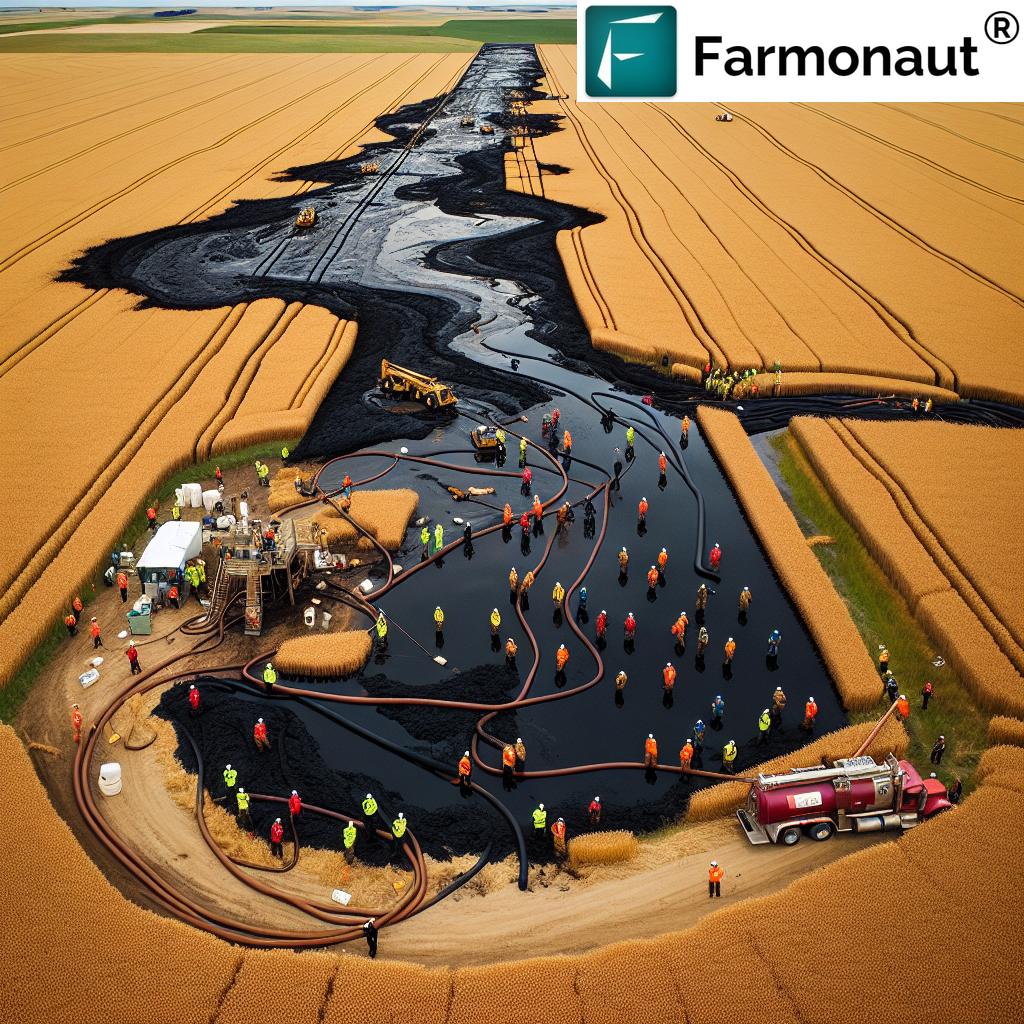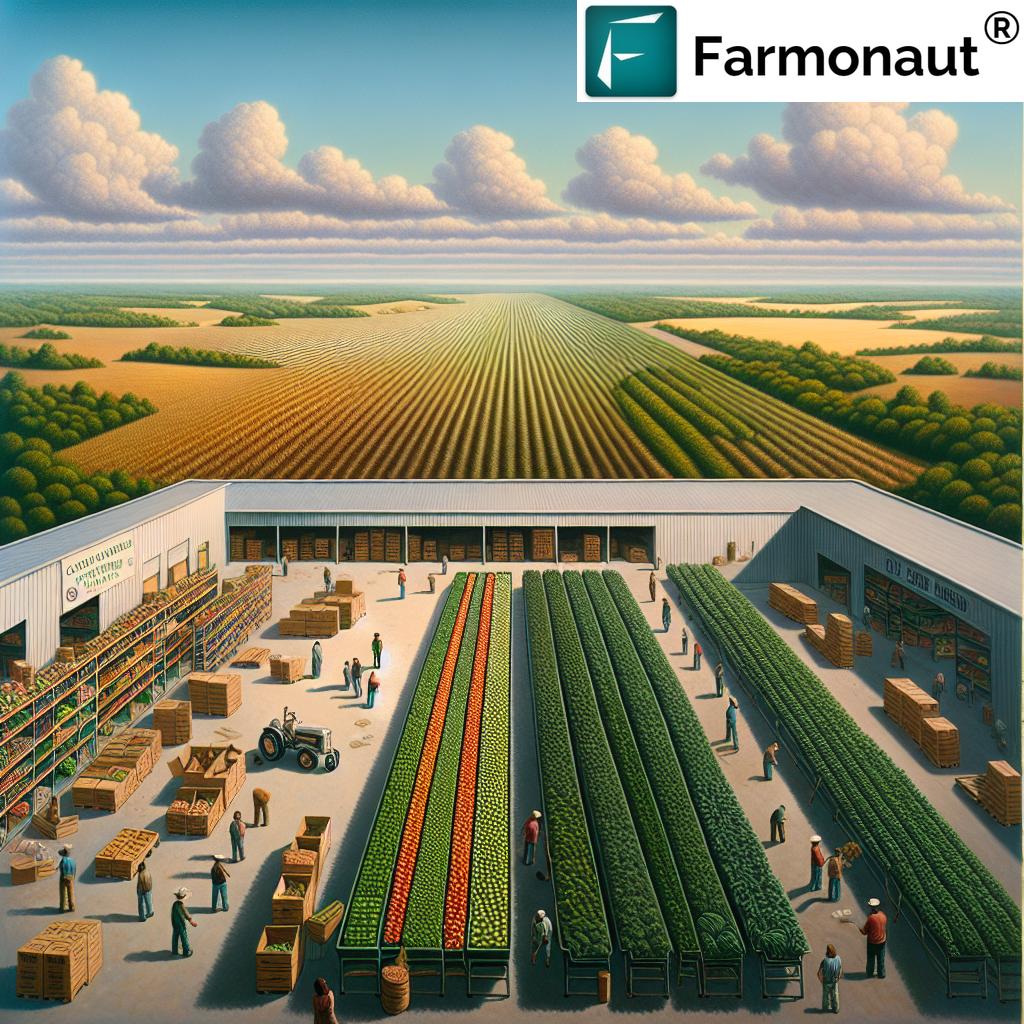Chicago Rail Hub: 7 Powerful Facts Shaping America’s Rail Network
Summary: Chicago—America’s Rail Crossroads
Chicago proudly stands as the largest rail hub in the United States, earning a distinguished title as the rail crossroads of America. Its immense infrastructure, strategic location connecting eastern and western, northern and southern railway routes, and ceaseless flow of freight and passenger trains make the Chicago rail hub an indispensable nexus in the national transportation network. For more than a century, this city’s comprehensive rail system has enabled seamless transfer of goods, crucial raw materials, and passengers across the country, fueling industrial prosperity and economic development on a massive scale.
Unlike online marketplaces or regulatory authorities, Farmonaut focuses on integrating advanced technology and data-driven insights into traditional industries like agriculture, amplifying the real-world impact that efficient rail and supply chain networks provide. As we uncover the powerful facts surrounding Chicago’s unrivaled rail hub, we see how modernization, sustainability, and connectivity are driving industry evolution.
“Chicago’s rail hub handles over 500 freight trains daily, making it the busiest rail gateway in North America.”
Chicago Rail Hub: Unmatched Significance in America’s Transportation Network
The Chicago rail hub is the architectural and operational heart of rail transportation in the United States. Its scale and complexity have transformed Chicago into the undisputed largest rail hub in the United States, handling an estimated 25% of all U.S. rail freight. This strategic intersection enables seamless movement of goods and passengers, with the city‘s location at the junction of the nation’s key railway lines amplifying its vital role.
Let’s break down why Chicago’s position is more than mere geographical luck—it is the result of conscious investment, infrastructural development, and continual modernization that has kept Chicago on the forefront of American rail transportation.
“Nearly 25% of all U.S. rail freight passes through Chicago, highlighting its pivotal role in national logistics.”
Railway Development in Chicago: Historical Roots and Modern Infrastructure
The roots of Chicago’s railway dominance stretch back to the mid-19th century. As the Midwest experienced explosive growth in agriculture, industry, and population, Chicago grew organically as a key transportation center. Its ability to funnel raw materials east for export and finished products westward underpinned its rise. The construction of Union Station and extensive freight yards forged a gateway for both people and freight movement across America.
Today, the city is served by a stunning array of Class I railroads, including:
- BNSF Railway
- Canadian National Railway
- Canadian Pacific Kansas City
- CSX Transportation
- Norfolk Southern Railway
- Union Pacific Railroad
Additionally, numerous regional and short line railroads branch out from Chicago, connecting the hub to virtually every part of North America and amplifying the network’s reach.
With thousands of trains transiting weekly, the Chicago rail hub manages enormous freight volume and supports the smooth transfer of goods and passengers, making it a linchpin in the national transportation chain.
7 Powerful Facts Shaping the Chicago Rail Hub
-
The Largest Rail Hub in the United States
Chicago is the nation’s busiest rail hub, handling over 500 freight trains daily and connecting six of the seven Class I railroads across North America. No other city‘s rail infrastructure rivals Chicago’s scale, number of intersecting railroads, or the complexity of its network. This massive volume is crucial for the movement of goods and materials across the continent, supporting both the local economy and the U.S. as a whole.
-
A Strategic Intersection for National and International Trade
Chicago’s geographical location at the crossroads of eastern and western, northern and southern routes makes it a pivotal nexus for rail transportation. The confluence of rail lines allows for seamless transfer of goods and passengers, linking ports on the Great Lakes and Gulf Coast, and facilitating trade between Canada, Mexico, and all corners of the United States. The city’s unique position is what sets it apart as the indispensable link in the country‘s transportation network.
-
Economic Impact and Scale
The Chicago rail hub generates billions of dollars in revenue annually, directly and indirectly supporting thousands of jobs in the region. It powers industries from manufacturing and agriculture to retail, by consistently delivering essential materials and finished products. The city’s rail infrastructure is integral for the movement of agricultural goods such as grains, corn, and soybeans, as well as coal, chemicals, intermodal containers, and automobiles.
-
Rail Infrastructure Modernization: The CREATE Program
Chicago is home to one of the largest transportation infrastructure initiatives in the country—the CREATE (Chicago Region Environmental and Transportation Efficiency) Program. This massive public-private partnership encompasses 70 projects designed to reduce congestion, improve efficiency, and enhance safety. The CREATE program is vital for supporting increasing traffic volume and ensuring continued effective management as freight movement across America expands.
-
Vital Passenger Rail Connections
In addition to freight, Chicago is a major center for passenger rail connections. Union Station remains the city’s primary intercity terminal, with Amtrak and the robust Metra commuter rail system facilitating millions of passengers each year. These services are indispensable for daily commutes, regional linkages, and national travel.
-
Intermodal Transportation Chicago: A Key Transfer Hub
The city’s major rail yards are essential for intermodal transportation in Chicago, serving as critical transfer points where containers are moved between trains and trucks. This system is crucial for the swift and efficient movement of goods across states and the entire continent, underpinning the modern supply chain.
-
Technology and Sustainability: Looking Forward
Innovative technologies—from advanced signaling systems and automated track inspections to real-time analytics and predictive maintenance—are transforming the Chicago rail network. Such advancements are poised to further improve efficiency, address congestion, and reduce environmental impact by offering alternatives to truck-based freight and enabling sustainability initiatives like carbon footprinting.
Comparative Data Table: Chicago vs. American Rail Hubs
To fully illustrate Chicago’s preeminence in the U.S. rail network, let’s compare it with other leading hubs by annual freight volume, daily train movements, infrastructure investment, and signature modernization projects, reflecting the city’s ongoing railway development.
| Rail Hub | Annual Freight Volume (Million Tons, est.) | Number of Railroads Intersecting | Daily Train Movements (est.) | Infrastructure Investment (Last Decade, USD est.) | Key Modernization Projects |
|---|---|---|---|---|---|
| Chicago, IL | >550 | 6 (Class I) | ~1300 | $4 billion+ | CREATE Program, Union Station Revitalization |
| Kansas City, MO | ~260 | 5 (Class I) | ~350 | $1 billion+ | Intermodal Expansion Projects |
| Los Angeles, CA | ~200 | 2 | ~250 | $2 billion+ | Alameda Corridor, On-Dock Rail Expansion |
| Atlanta, GA | ~160 | 3 | ~180 | $1.5 billion+ | South Atlanta Intermodal Terminal |
For those interested in sustainable farming and the environmental impact of rail shipping, explore Farmonaut’s Carbon Footprinting solution—track emissions and reduce your agricultural carbon footprint.
Looking to boost transparency along your crop’s journey from field to consumer? Farmonaut’s Blockchain-Based Product Traceability uses cutting-edge blockchain to strengthen trust in your agricultural supply chain.
Large agri-enterprises can maximize efficiency leveraging Farmonaut’s Fleet Management tools, optimizing all machinery and logistics with satellite-powered data insights.
Integrate real-time satellite and weather insights into your agricultural management system with the Farmonaut API. Developers can access technical documentation at API Developer Docs.
Chicago Rail Network: Challenges, Congestion, and Solutions
While the Chicago rail hub remains America’s logistical powerhouse, operational complexity brings persistent rail congestion. Increasing traffic volume, aging infrastructure, and extreme climate factors (like winters characterized by snow and ice) routinely challenge the efficiency and safety of rail operations.
Common Challenges Facing the Chicago Rail System
- Infrastructure Bottlenecks: Many lines and yards were built over a century ago, making them less suited to today’s larger and faster trains.
- Congestion: The sheer volume of freight, containers, and passenger trains creates delays, especially during peak hours and inclement weather.
- Safety: The need for improved signaling, grade separation, and real-time monitoring grows as traffic increases.
- Weather Impact: Chicago’s winters can halt or slow operations, with ice and snow affecting switches, tracks, and equipment.
- Sustainability: Modernizing to reduce environmental footprint is essential as regulatory and social expectations increase.
- Digital Integration: Adopting new technologies across legacy systems requires significant planning and investment.
Implementing Rail Congestion Solutions
-
Infrastructure Upgrades:
The CREATE Program stands out, tackling congestion through grade separations, modern signaling, and expanded freight yards. -
Advanced Technologies:
From positive train control (PTC) to AI-driven signaling, technology is helping to predict and prevent delays, improve safety, and boost efficiency. -
Digital Monitoring:
Real-time analytics and predictive maintenance minimize downtime and enable prioritized scheduling. -
Weather Protocols:
Rail operators have developed specialized response plans for winter weather, such as track heating and rapid snow removal systems, ensuring minimal disruption.
Future-Proofing Chicago: Rail Infrastructure Modernization & the Path Ahead
The future of the Chicago rail hub revolves around continuous investment in modernization and sustainability. The integration of advanced technologies—including predictive maintenance, digital twins, and data analytics—is reshaping how traffic is managed, safety enforced, and delays addressed.
Key modernization goals include:
- Supporting Increasing Traffic Volume: Adaptation to support even more freight and passenger trains by expanding lines, yards, and terminals.
- Boosting Efficiency & Reliability: Implementing automation (e.g., automated inspections, dynamic scheduling) and AI-driven resource allocation.
- Enhancing Sustainability: Exploring electrification, expanding intermodal capabilities, and deploying carbon footprinting tools to reduce environmental impact—mirroring how Farmonaut’s satellite-based reporting empowers green decision-making in agriculture.
- Meeting 21st Century Demands: Adapting to new supply chain realities and evolving industry trends, ensuring Chicago’s continued national and global prominence.
With these advances, the Chicago rail network positions itself to meet tomorrow’s demands in freight, passenger, and goods movement—setting a global benchmark for what a modern, resilient rail hub can achieve.
Farmonaut: Powering Modern Agriculture, Linked by Rail Infrastructure
Just as Chicago’s rail hub redefines efficiency and connectivity in American transportation, Farmonaut is revolutionizing precision agriculture for a sustainable and traceable future. Both systems share a common goal: harnessing the power of technology and data to build a modern, robust, and adaptive network.
Farmonaut’s Suite of Agri-Tech Solutions:
- Satellite-Based Crop Health Monitoring—Access real-time insights on crop vigor, soil moisture, and field anomalies. Helps farmers and agribusinesses synchronize supply chain logistics with the pace of harvest, directly impacting demand for freight movement via rail.
- AI-Driven Jeevn Advisory Systems—Receive tailored guidance for crop health, weather, and resource allocation that feeds into wider supply networks.
- Blockchain-Based Product Traceability: Build consumer trust and streamline compliance by tracing every step of the agriculture production and delivery process. See more on product traceability.
- Fleet and Resource Management—Map and optimize the deployment of vehicles and farm machinery, linking field to rail yard.
- Carbon Footprinting Tools—Empower agri-enterprises to reduce emissions across production and transportation with precision carbon tracking.
Farmonaut’s subscription-based service is available via web or mobile app, making it globally accessible for individual farmers, cooperatives, government bodies, and enterprise clients.
Looking for API integration? Visit our API platform or developer documentation for seamless, secure data exchange and satellite-powered analytics.
Frequently Asked Questions: Chicago Rail Hub & America’s Rail Network
Why is Chicago considered the largest rail hub in the United States?
Chicago sits at the vital crossroads of America’s east-west and north-south rail corridors, serving as the intersection point for six of the seven Class I railroads. The city’s infrastructure handles over 500 freight trains a day and roughly a quarter of all U.S. rail freight, making it the undisputed anchor for the nation’s rail transportation network.
What is the impact of rail transportation in Chicago on the national economy?
The scale of the Chicago rail hub supports billions of dollars in commerce annually. By facilitating the efficient movement of crucial goods—raw materials, finished products, and agricultural commodities—across the United States, Chicago supports both the regional and national economy, influencing industries from manufacturing to agriculture and retail.
What commodities and products primarily pass through Chicago’s rail network?
The diversity is vast: from agricultural goods (grains, corn, soybeans) and coal, to chemicals, automobiles, intermodal containers, and building materials. This variety underscores Chicago’s critical support for a wide spectrum of industries and the seamless transfer of goods across the country.
How does the CREATE Program improve Chicago’s rail infrastructure?
The CREATE Program is a $4 billion+ infrastructure initiative involving more than 70 projects to reduce rail congestion, streamline freight and passenger movement, and improve environmental outcomes. Its focus is on modernizing key bottlenecks, installing new signaling, and expanding intermodal facilities to keep pace with modern logistics.
What role does intermodal transportation play in Chicago’s hub status?
Intermodal transportation—the movement of freight via multiple transportation modes, primarily trains and trucks—is central to Chicago’s operation. The city’s rail yards act as national gateways for containerized goods, enabling swift, efficient transfer and propelling the movement of products across North America.
How are Chicago’s harsh winters managed on the rail network?
Winters bring increased risk of delays and equipment issues due to snow, ice, and extreme cold. The city’s rail operators implement weather protocols such as track heating, rapid snow removal, and real-time monitoring to minimize impacts and maintain operational continuity.
How does technology contribute to rail infrastructure modernization in Chicago?
Technology underpins much of Chicago’s modernization—advanced signaling, real-time data analytics, automated inspections, and maintenance predictions drive higher efficiency, safety, and network reliability, ensuring the city’s rail system can meet future demands.
How does Chicago’s network compare to other major American rail hubs?
By every metric—annual freight volume, number of intersecting railroads, traffic complexity, and investment—Chicago outpaces peers like Kansas City, Atlanta, and Los Angeles. Its role as the central transfer and intermodal point is unmatched in the nation’s rail transportation ecosystem.
Conclusion: Chicago Rail Hub—Powering America’s Rail Future
Chicago’s position as the largest rail hub in the United States is secured not just by historical legacy, but by ongoing investment, modernization, and adaptability. The city’s pivotal rail network connects raw material producers, manufacturers, and consumers—facilitating seamless freight movement across America and bolstering economic prosperity throughout the region and nation.
As we look ahead, the pursuit of rail infrastructure modernization will ensure that Chicago rail hub continues to drive industrial progress, supply chain innovation, and sustainable development. Parallelly, advanced platforms like Farmonaut empower the agricultural sector—the lifeblood of many rail shipments—using technology and data-driven insights to optimize productivity and sustainability.
Together, railway development in Chicago and the digital transformation of agriculture support a resilient, interconnected, and thriving America. For those invested in either rail or agri-technology, this is the future—built on smart investments, adaptive strategies, and seamless connectivity.
Ready to connect your agribusiness with the future of rail and technology? Learn more about Farmonaut’s platform and solutions available for every scale of farming and logistics.
















